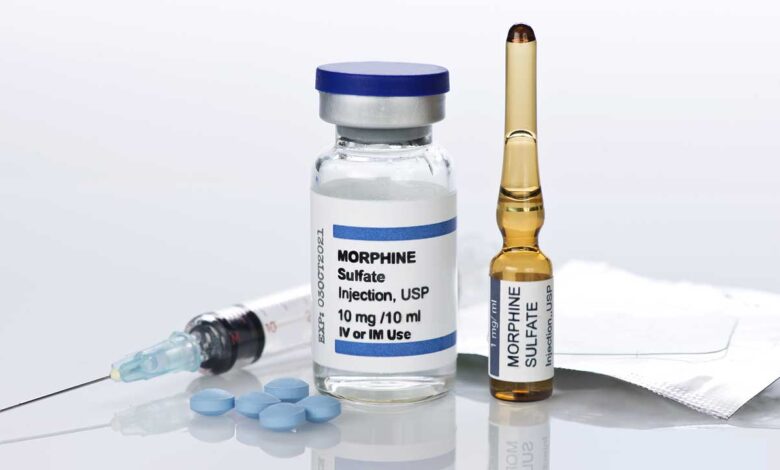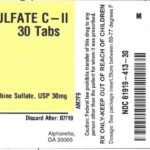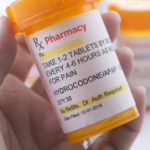Morphine: Uses, Side Effects, Abuse, Addiction

Morphine belongs to a class of medications called opiate (narcotic) analgesics. It works by changing the way the brain and nervous system respond to pain. It is found naturally in a dark brown, resinous form, from the poppy plant Papaver somniferum and it is produced synthetically. Morphine binds to and activates specific opiate receptors (delta, mu, and kappa), each of which is involved in controlling different brain functions.
Medically morphine is used to relieve moderate to severe pain. Morphine extended-release tablets and capsules are only used to relieve severe (around-the-clock) pain that cannot be controlled by the use of other pain medications. Morphine extended-release tablets and capsules should not be used to treat pain that can be controlled by medication that is taken as needed.
Morphine is a DEA-controlled drug and a DEA Schedule II controlled substance. Substances in the DEA Schedule II have a high potential for abuse which may lead to severe psychological or physical dependence. Morphine is classified by the DEA as a Narcotics (Opioids) drug.
How quickly does morphine work?
Morphine onset of action and the speed at which it works can vary depending on the route of administration. Here are some common methods of administering morphine and their respective onset times:
1. Intravenous (IV) injection: When administered intravenously, morphine works very quickly, with the onset of action typically occurring within a few minutes. The effects are felt almost immediately as the drug enters the bloodstream directly.
2. Intramuscular (IM) injection: The onset of action for morphine given via intramuscular injection is slightly slower compared to IV administration. It usually takes around 10 to 20 minutes for the effects to be felt as the drug is absorbed from the muscle tissue into the bloodstream.
3. Subcutaneous (SC) injection: Subcutaneous administration of morphine has a similar onset time to intramuscular injection, taking approximately 10 to 20 minutes for the effects to be felt.
4. Oral administration: When taken orally in the form of tablets or capsules, the onset of action for morphine is typically slower, ranging from 30 minutes to an hour or more. This delay is due to the time it takes for the drug to be absorbed from the gastrointestinal tract into the bloodstream.
It’s important to note that individual responses to morphine can vary. Factors such as the individual’s metabolism, overall health, and the presence of other medications can influence how quickly the drug takes effect. Additionally, the dosage of morphine prescribed can also impact the onset and intensity of its effects.
If you have any concerns or questions about the timing or effectiveness of morphine for your specific situation, it’s recommended to consult with your healthcare provider. They can provide personalized guidance and support based on your needs and medical condition.
How should morphine be used?
Morphine comes as a solution (liquid), an extended-release (long-acting) tablet, and as an extended-release (long-acting) capsule to take by mouth. The oral solution is usually taken every 4 hours as needed for pain. MS Contin brand and Arymo ER brand are extended-release tablets that are usually taken every 8 or every 12 hours. Morphabond brand extended-release tablets are usually taken every 12 hours. Kadian brand extended-release capsules are usually taken with or without food every 12 hours or every 24 hours. Follow the directions on your prescription label carefully, and ask your doctor or pharmacist to explain any part you do not understand.
If you are taking morphine solution, use the dosing cup or syringe that comes with the medication to measure your dose. Be sure that you know how many milliliters of the liquid you should take. Ask your pharmacist if you have any questions about how much medication you should take or how to use the dosing cup or syringe.
If you are taking Kadian brand extended-release capsules and you have a gastrostomy tube (surgically inserted feeding tube), ask your doctor or pharmacist how to administer the medication through your tube.
If you are unable to swallow the extended-release capsules (Kadian), you can carefully open a capsule, sprinkle all of the beads that it contains on a spoonful of cold or room temperature applesauce, and swallow the entire mixture immediately without chewing or crushing the beads. Then rinse your mouth with a little water and swallow the water to be sure that you have swallowed all the medication. Do not mix the beads into any other food. Do not save mixtures of medication and applesauce for later.
If you are taking the extended-release tablets (Arymo ER), swallow them one at a time with plenty of water. Swallow the extended-release tablets right after putting it in your mouth. Do not presoak, wet, or lick the extended-release tablets before you put them in your mouth.
Your doctor may start you on a low dose of morphine and gradually increase your dose until your pain is controlled. Your doctor may adjust your dose at any time during your treatment if your pain is not controlled. If you feel that your pain is not controlled, call your doctor. Do not change the dose of your medication without talking to your doctor.
Do not stop taking morphine without talking to your doctor. Your doctor may decrease your dose gradually. If you suddenly stop taking morphine, you may experience withdrawal symptoms such as restlessness; teary eyes; runny nose; yawning; irritability; anxiety; sweating; difficulty falling asleep or staying asleep; chills; back, muscle, or joint pain; nausea; vomiting; loss of appetite; diarrhea; stomach cramps; weakness; fast heartbeat; or fast breathing.
What side effects can this medication cause?
Morphine may cause side effects. Tell your doctor if any of these symptoms are severe or do not go away:
- drowsiness
- stomach pain and cramps
- dry mouth
- headache
- nervousness
- mood changes
- small pupils (black circles in the middle of the eyes
- difficulty urinating or pain when urinating
Some side effects can be serious. If you experience any of the following symptoms, call your doctor immediately:
- blue or purple color to the skin
- changes in heartbeat
- agitation, hallucinations (seeing things or hearing voices that do not exist), fever, sweating, confusion, fast heartbeat, shivering, severe muscle stiffness or twitching, loss of coordination, nausea, vomiting, or diarrhea
- nausea, vomiting, loss of appetite, weakness, or dizziness
- inability to get or keep an erection
- irregular menstruation
- decreased sexual desire
- seizures
- extreme drowsiness
- fainting
- chest pain
- fever
- hives
- rash
- itching
- swelling of the eyes, face, mouth, lips or throat
- hoarseness
- difficulty breathing or swallowing
Morphine may cause other side effects. Call your doctor if you have any unusual problems while you are taking this medication.
Morphine Safety Information
Morphine may be habit forming, especially with prolonged use. Take morphine exactly as directed. Do not take more of it, take it more often, or take it in a different way than directed by your doctor. While you are taking morphine, discuss with your healthcare provider your pain treatment goals, length of treatment, and other ways to manage your pain. Tell your doctor if you or anyone in your family drinks or has ever drunk large amounts of alcohol, uses or has ever used street drugs, or has overused prescription medications, or has had an overdose, or if you have or have ever had depression or another mental illness. There is a greater risk that you will overuse morphine if you have or have ever had any of these conditions. Talk to your healthcare provider immediately and ask for guidance if you think that you have an opioid addiction or call the U.S. Substance Abuse and Mental Health Services Administration (SAMHSA) National Helpline at 1-800-662-HELP.
Morphine may cause serious or life-threatening breathing problems, especially during the first 24 to 72 hours of your treatment and any time your dose is increased. Your doctor will monitor you carefully during your treatment. Your doctor will adjust your dose carefully to control your pain and decrease the risk that you will experience serious breathing problems. Tell your doctor if you have or have ever had slowed breathing or asthma. Your doctor may tell you not to take morphine. Also tell your doctor if you have or have ever had lung disease such as chronic obstructive pulmonary disease (COPD; a group of lung diseases that includes chronic bronchitis and emphysema), a head injury, a brain tumor, or any condition that increases the amount of pressure in your brain. The risk that you will develop breathing problems may be higher if you are an older adult or are weakened or malnourished due to disease. If you experience any of the following symptoms, call your doctor immediately or get emergency medical treatment: slowed breathing, long pauses between breaths, or shortness of breath.
Taking certain other medications during your treatment with morphine may increase the risk that you will experience breathing problems or other serious, life-threatening breathing problems, sedation, or coma. Tell your doctor if you are taking or plan to take any of the following medications: benzodiazepines such as alprazolam (Xanax), diazepam (Diastat, Valium), estazolam, flurazepam, lorazepam (Ativan), and triazolam (Halcion); cimetidine (Tagamet); other narcotic pain medications; medications for mental illness or nausea; muscle relaxants; sedatives; sleeping pills; or tranquilizers. Your doctor may need to change the dosages of your medications and will monitor you carefully. If you take morphine with any of these medications and you develop any of the following symptoms, call your doctor immediately or seek emergency medical care: unusual dizziness, lightheadedness, extreme sleepiness, slowed or difficult breathing, or unresponsiveness. Be sure that your caregiver or family members know which symptoms may be serious so they can call the doctor or emergency medical care if you are unable to seek treatment on your own.
Drinking alcohol, taking prescription or nonprescription medications that contain alcohol, or using street drugs during your treatment with morphine increases the risk that you will experience breathing problems or other serious, life-threatening side effects. If you are taking Avinza brand long-acting capsules, it is especially important that you do not drink any drinks that contain alcohol or take any prescription or nonprescription medications that contain alcohol. Alcohol may cause the morphine in Avinza® brand long-acting capsules to be released in your body too quickly, causing serious health problems or death. Do not drink alcohol, take any prescription or nonprescription medications that contain alcohol, or use street drugs during your treatment with other morphine products.
Tell your doctor if you are pregnant or plan to become pregnant. If you take morphine regularly during your pregnancy, your baby may experience life-threatening withdrawal symptoms after birth. Tell your baby’s doctor right away if your baby experiences any of the following symptoms: irritability, hyperactivity, abnormal sleep, high-pitched cry, uncontrollable shaking of a part of the body, vomiting, diarrhea, or failure to gain weight.
Your doctor or pharmacist will give you the manufacturer’s patient information sheet (Medication Guide) when you begin treatment with morphine and each time you fill your prescription if a Medication Guide is available for the morphine product you are taking. Read the information carefully and ask your doctor or pharmacist if you have any questions.
How to overcome morphine abuse
Overcoming morphine abuse requires a comprehensive approach and professional support. If you or someone you know is struggling with morphine abuse, here are some steps that can help:
1. Acknowledge the problem: Recognize and accept that there is a problem with morphine abuse. Understand the negative impact it is having on your life and the importance of seeking help.
2. Seek professional help: Consult a healthcare professional or addiction specialist who can provide guidance and support throughout the recovery process. They can assess your situation, develop a personalized treatment plan, and monitor your progress.
3. Detoxification: If you are physically dependent on morphine, a medically supervised detoxification process may be necessary to safely manage withdrawal symptoms. Detoxification helps your body rid itself of the drug while minimizing discomfort and potential complications.
4. Therapy and counseling: Engage in individual therapy or counseling to address the underlying issues contributing to the abuse. Behavioral therapies, such as cognitive-behavioral therapy (CBT), can help you identify triggers, develop coping skills, and modify negative thought patterns and behaviors.
5. Support groups: Join a support group, such as Narcotics Anonymous (NA), to connect with others who have experienced or are experiencing similar struggles. Sharing experiences, learning from others, and receiving support can be immensely helpful during recovery.
6. Medication-assisted treatment: In some cases, medication-assisted treatment (MAT) may be recommended. MAT combines medications, such as buprenorphine or methadone, with behavioral therapies to help manage cravings and reduce the risk of relapse.
7. Develop healthy coping mechanisms: Identify healthier ways to cope with stress and emotional difficulties. Engage in activities that promote physical and mental well-being, such as exercise, mindfulness, hobbies, and creative outlets.
8. Build a support network: Surround yourself with a supportive and understanding network of family, friends, and peers who are committed to your recovery. Openly communicate with them about your challenges, progress, and goals.
9. Create a structured routine: Establish a structured daily routine that includes regular sleep patterns, healthy meals, exercise, and meaningful activities. Structure and routine can help fill the void left by the absence of morphine abuse and provide stability during the recovery process.
10. Stay committed and be patient: Recovery is a gradual process that takes time and effort. Be patient with yourself and stay committed to your recovery goals, even if there are setbacks along the way. Celebrate small victories and seek support when needed.
Remember, overcoming morphine abuse is a journey that requires professional guidance, support from loved ones, and personal commitment. Reach out for help, take it one day at a time, and believe in your ability to recover and lead a healthier, substance-free life.




